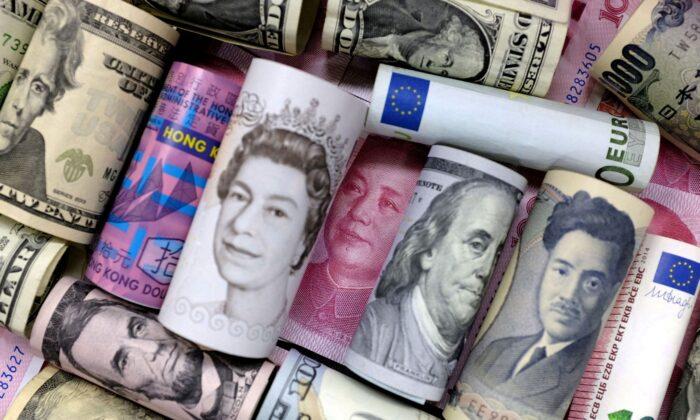NEW YORK—The dollar climbed on Wednesday while the euro weakened as oil prices saw another jump with U.S. President Joe Biden poised to announce, alongside other European leaders, new sanctions against Russia during his trip to Europe.
Biden is due to arrive in Brussels later on Wednesday on his first foreign trip since the war in Ukraine began, and will meet NATO and European leaders in an emergency summit at the Western military alliance’s headquarters.
Prices for commodities such as oil and wheat have climbed as tensions in Ukraine have escalated, putting additional upward pressure on already high inflation due to supply chain bottlenecks. Rising inflation has led many central banks including the U.S. Federal Reserve to take measures to rein in prices, such as by raising interest rates.
“The capital flow is going to be I don’t want to be in Europe, it is closer to Ukraine literally in the geographical sense but also it is the fallout from the sanctions, there is a lot of money rotating back out of Europe and back towards the States,” said Huw Roberts, head of analytics at Quant Insight.
“If we get another round of sanctions, then people therefore say the blowback on the West is going to fall on Europe disproportionately.”
The dollar index rose 0.291 percent, with the euro down 0.46 percent to $1.0976.
Crude prices were up more than 4 percent on Wednesday, supported by disruption to Russian and Kazakh crude exports.
Federal Reserve Chair Jerome Powell raised the possibility of raising interest rates by more than 25 basis points at upcoming meetings, a more aggressive stance echoed by other policymakers, which has supported the greenback and helped boost the yield on the benchmark 10-year U.S. Treasury note to more than 2.4 percent.
Jefferies on Wednesday updated its Fed forecast in light of Powell’s comments and now sees a 50 basis point rate hike at both the May and June meetings, followed by 25 basis point hikes at the remaining meetings of 2022.
The Japanese yen weakened 0.13 percent to 120.92 per dollar, while Sterling was last trading at $1.3197, down 0.50 percent on the day after earlier hitting a three-week high of $1.3298.
British inflation shot up faster than expected last month to hit a new 30-year high at a 6.2 percent year-over-year rise. British finance minister Rishi Sunak cut taxes for workers and reduced a duty on fuel on the heels of the inflation data as he sought to soften a severe cost-of-living squeeze against the backdrop of fast-rising prices and slowing economic growth.
The yen has been weak against the dollar recently, with the currency slipping to a new six-year low of 121.40 per dollar as the path of their respective central banks has diverged. Bank of Japan Governor Haruhiko Kuroda said on Tuesday the central bank must maintain ultra-loose monetary policy as recent cost-push inflation could hurt the economy.
In cryptocurrency markets, Bitcoin last fell 0.8 percent to $42,255.92.
Ethereum last fell 0.49 percent to $2,987.47.





